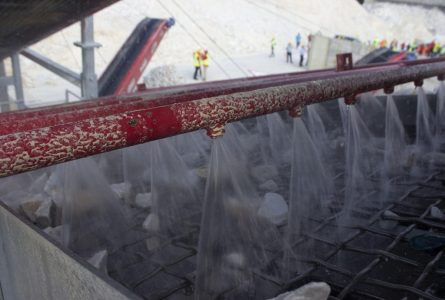The Basics of Wastewater Treatment for Concrete Production Applications
In the past, dry screening was a common practice in the concrete wastewater treatment mining industry. However, as global markets advance, more efficient washing systems have emerged as the preferred method for producing silt-free materials. Mining companies that use washing and scrubbing systems can ensure higher-quality end products by effectively eliminating contaminants.
Why Mining Concrete Wastewater Treatment Companies Use Washing Systems
Mining companies employ washing systems to improve the quality of their target products by reducing and eliminating unwanted materials. Contaminants such as chemical or mineral impurities can degrade product quality, making washing an essential step in the refining process.
Washing systems also play a crucial role in accurately separating materials based on particle size. Unlike dry separation systems that rely on gravity or air currents, water-based washing screens provide more precise cut-points and higher efficiency at small apertures.
Dry Separation vs. Washing Systems
Dry Separation
Dry separation methods, such as standard sizing screens for coarse fractions or air classifiers for sand and fines, cannot match the efficiency and final product quality of modern washing systems. Factors such as latent moisture content, sticky or agglomerated materials, and the presence of low-mass contaminants can be better addressed through wet washing systems.
Common Contaminants Requiring Removal:
- Excess fines (<75μm / 200#) in concrete sand
- Excess sea minerals in marine-dredged sand
- Sulfates found in sand deposits
- Surface contaminants (e.g., FeO2 in high-quality silica sand)
- Clays adhering to aggregates or minerals
- Trash in recycled materials (e.g., plastic, paper, grass in construction debris)
- Oils and heavy metals in excavated soils or tar sands
Each of these contaminants requires a well-designed washing system to achieve optimal efficiency and quality.
Common Applications for Washing Systems
Construction Materials Sector
The most frequent use of washing systems is in the construction industry, particularly for concrete sand production. International standards dictate specific size parameters for concrete sand, including limitations on fines. Excess fines can lead to:
- Inconsistent internal coherence, causing cracks
- Uneven drying times, resulting in blemishes
- Increased cement consumption due to higher surface area
Specialist Applications
Specialist sands require precise particle size distribution and stringent chemical composition controls. Examples include:
- Silica sand for glass manufacturing – Requires narrow granule size distribution and reduced metal contaminants such as FeO2.
- Frac sand processing – Needs extremely narrow particle size distribution.
- Sports sands – Used for USPGA golf courses and similar applications.
- Water treatment filter beds – Requires high-purity sands for filtration.
- Contaminated soils – Requires removal of oils and heavy metals.
- Oil sands processing – Requires specialized scrubbing and separation.
For such applications, advanced washing systems may include hydrocyclone circuits, high-frequency screens, vertical spiral classifiers, and magnetic separation technologies.
Washing Equipment for the Mining Industry
Matec provides three primary approaches for cleaning and sizing aggregates: screening and scrubbing.
Matec ScreenTec: Wet and Dry Screening Units
ScreenTec units divide aggregate and mineral feed into desired size fractions. Most screening in mining and construction industries is dry. However, in cases where residual moisture, fines, sticky clay, or other contaminants are present, introducing water into the equation significantly improves quality and efficiency.
Matec ScrubTec: Logwashers
ScrubTec logwashers are specifically designed for mined and quarried materials with persistent clay or soil adhesion. These systems include:
- Twin parallel shafts with abrasion-resistant blades.
- Aggressive agitation to remove contaminants.
- Integrated water flow for enhanced scrubbing.
ScrubTec logwashers are ideal for breaking down tough clay materials and enhancing overall material quality.
AggreTec: Modular Single-Platform Washing Systems
AggreTec revolutionizes materials handling and washing by integrating multiple components into a single, easily deployable system. Unlike conventional setups that require separate units, AggreTec includes:
- Feed hopper with multiple grid options
- Robust feed conveyor
- Customizable washing screen with 2 or 3 decks
- Sand washing system for one or two sand products
- Up to five product stockpilers
- Fully integrated electrical controls with optional remote management
- Factory-installed pipework and pre-wiring
AggreTec simplifies deployment, reducing setup time and improving operational efficiency.
The ChemREADY Advantage
ChemREADY is your go-to partner for wastewater treatment management in mining and construction. In addition to providing high-quality washing systems, we offer:
- Industry-leading water treatment chemicals
- Customized solutions for different applications
- Technical expertise in optimizing washing efficiency
For more information about our washing systems and how we can help you optimize your operations, contact the ChemREADY team today.
About The Author
Nick Piskura is the Marketing and Web Development Specialist at ChemREADY who utilizes expertise in digital marketing strategies to provide knowledgeable insights in each segment of our business. Nick provides insights through web development and multimedia resources that support ChemREADY’s full range of services, including Legionella management, ANSI/AAMI ST108 compliance, boiler and cooling tower treatment, wastewater processing, and industrial water quality solutions.

